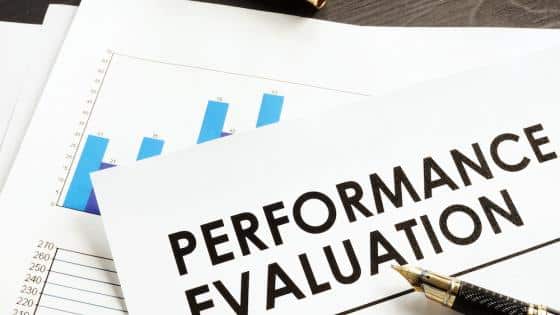Performance evaluation is an important process for assessing the effectiveness of an employee’s work and providing feedback on areas for improvement. It is a tool used by employers to help determine an individual’s strengths and weaknesses, and to set goals for them to achieve in the future. Performance evaluations are also used to assess an employee’s suitability for promotions and other job opportunities. We’ll talk about what performance evaluation means, the different ways to do it, comments, reports, and other related topics in this article.
Performance Evaluation Methods
- Performance evaluation methods are typically used to assess the quality of an employee’s work. It also helps provide feedback on areas of improvement. There are several different types of performance evaluation methods, which include:
- Observation: This method involves observing an employee’s work over a period of time and documenting their performance. This can also include observing their interactions with customers and colleagues, as well as their work habits.
- Checklists: This method involves using a pre-determined checklist to assess an employee’s performance. This type of evaluation is usually used to assess an employee’s job knowledge and skills.
- Surveys: This method involves surveying an employee’s supervisor and colleagues about their performance. Surveys can also be used to assess an employee’s job satisfaction and their opinions about the company’s policies and procedures.
- 360-Degree Feedback: This method involves assessing an employee’s performance by receiving feedback from their supervisor, colleagues, and customers. This type of evaluation is typically used to assess an employee’s interpersonal skills and customer service abilities.
- Self-Assessment: This method involves having an employee assess their own performance. This type of evaluation is typically used to assess an employee’s knowledge and skills, as well as their job satisfaction.
These are the five most common methods of performance evaluation. Each of these methods has its own advantages and disadvantages. However, it is important to choose the right one for your organization.
Performance Evaluation Examples
Employee performance evaluation language is still crucial for the continued growth of your team, despite this. These performance evaluations assist you as you thank your personnel for their efforts. They also assist you in identifying any areas where employees need to improve or alter a particular behavior that can be harmful to their success in the workplace.
Not sure what to say in a performance evaluation for a worker? To get your writing process going, here are evaluation examples to help you out.
Productivity
Henry is an enthusiastic teammate who makes work enjoyable. He produces work of excellent quality and exhibits superior technical proficiency. He shows remarkable attention to detail and takes the time to completely comprehend the scope of tasks, although frequently at the sacrifice of efficient time management.
Execution delays and a failure to meet production targets are the results of this. I’ll be collaborating with Henry during the upcoming quarter to find approaches to boost output levels without sacrificing the caliber of the work. This could involve things like contacting Henry every morning to establish daily progress targets. It could also involve assisting him in keeping track of the amount of time spent on various chores each week.
Problem-solving
Mary exemplifies a data-driven, pragmatic approach to issue-solving. She actively asks her teammates for their unique viewpoints and original ideas, and she never stops experimenting to get outcomes.
After our annual conference saw a drop in attendance, Mary facilitated the gathering of former attendees’ input, which identified critical themes for development. She collaborated with our marketing team to improve the targeting of our Facebook advertisements and to create a strategic outreach plan that included reaching out to influencers in our sector. Our event evaluation scores improved and attendance increased by 25% compared to the prior year as a result of these initiatives.
Learning Ability
Fred just transferred to our Product team from a job on our Customer Success team. Despite the steep learning curve that comes with changing careers, Fred is already excelling in his new position. He exhibits a quick learning curve and a desire to diversify his skill set.
Fred routinely takes the initiative to point out areas where the Product team might be improved and then takes the lead in resolving those problems. He used his understanding of consumer requirements toward the end of last year to enhance a crucial aspect of our product. He has demonstrated a strong interest in learning programming basics, which were necessary for this. In order to advance his skills, Fred is currently enrolled in a three-month beginning programming course, working on it for four hours each week.
Communication
Since our last review period, Lisa’s communication abilities have improved. She keeps her team members informed about the work she is doing and answers emails in a timely manner. She has promised to deliver a weekly progress report and show up to her one-on-one sessions with prepared notes in order to assist in achieving this.
Yet Lisa still needs to work on being more responsible and willing to take responsibility when initiatives don’t live up to expectations. She has the propensity to become defensive and shift responsibility away from herself when confronted with challenging circumstances.
Coaching/Mentorship
Richmond has been a fantastic role model and guide for our young engineers. He is committed to assisting our aspiring engineers in comprehending our technical environment and exhorts them to approach all they do from a solution-oriented perspective. Richmond has also shown dedication to his direct reports’ professional growth and excitement for enhancing their skill set through frequent coaching sessions.
Two of Richmond’s staff members have earned certifications to expand their skills over the most recent quarter, and his team has taken part in a virtual conference sponsored by thought leaders in the field. Being an Electrical Engineer with a strong work ethic, Richmond has continued to carry out the tasks assigned to him. He may, however, increase his success rate for meeting deadlines by more skillfully assigning work.
Engagement
With four years of experience at our company, Monica is a seasoned team member with a strong foundation in institutional knowledge. She works well with team members across functional lines and only needs minimal supervision to do her job.
Monica lacks dedication to her own professional development and displays little interest in meetings and team-building exercises. We’d like Monica to concentrate on establishing more ambitious personal goals during the following three months. Also, I will work closely with her to find learning activities that will advance her professional development. We are hoping that by taking these actions, she would be inspired to acquire the abilities required for career advancement inside the company.
Leadership
After taking over as Director of Human Resources, Martin has proven to be an excellent leader. Martin challenges his direct reports to reach their own personal goals and objectives for professional progression and chances inside the firm. He also understands how to motivate and guide team members efficiently in order to fulfill company goals.
He backs the decisions made by his staff members and is a team player inside the business. Before developing comprehensive answers to issues and obstacles, Martin frequently seeks the broad perspective of other team members. To his team, Martin has occasionally failed to convey information clearly, which has led to a lack of transparency. I’m looking forward to him being more accessible to provide input and alert his colleagues to any early problems he encounters.
What are the 4 types of performance evaluation?
The four types of performance evaluation are:
- Manager Evaluation: The manager or supervisor of the employee is in charge of this type of evaluation. The manager evaluates the employee’s performance in terms of their job knowledge, skills, and abilities.
- Self-Evaluation: The employee themselves access this type of evaluation. The employee evaluates their own performance in terms of their job knowledge, skills, and abilities.
- Peer Evaluation: This type of evaluation is done by the employee’s colleagues or peers. The peers evaluate the employee’s performance in terms of their job knowledge, skills, and abilities.
- 360-Degree Evaluation: This type of evaluation is done by the employee’s supervisor, colleagues, and customers. The 360-degree evaluation assesses the employee’s performance in terms of their job knowledge, skills, and abilities, as well as their interpersonal skills and customer service abilities.
Performance Evaluation Comments
Performance evaluation comments are important for providing feedback to employees. It is better to pen them down in a constructive and professional manner and should focus on areas of improvement as well as areas of success. Here are some examples of performance evaluation comments:
- Positive Comments: “You have been very successful in meeting your deadlines, and I am impressed with your ability to manage your time effectively.”
- Constructive Comments: “I have noticed that you have been having difficulty with communication with your colleagues. I suggest that you spend more time practicing your communication skills.”
- Encouraging Comments: “I am very impressed with your progress so far. Keep up the good work and I am sure that you will be successful in the future.”
These are some examples of performance evaluation comments. It is important to provide constructive and encouraging feedback to employees in order to help them improve their performance.
Performance Evaluation Report
A performance evaluation report is an important document used to assess the performance of an employee. It should include information about the employee’s performance, their strengths and weaknesses, and areas of improvement. The report should also include the employee’s goals and objectives, and any areas where they need to improve.
The performance evaluation report should be written in a professional and objective manner. It should include the employee’s performance over the past year, as well as any goals or objectives they have achieved. The report should also include any areas where the employee could improve and any areas of strength or weakness.
What are the three methods of performance evaluation?
The three methods of performance evaluation are observation, checklists, and surveys. Observation involves observing an employee’s work over a period of time and documenting their performance. Checklists involve using a pre-determined checklist to assess an employee’s performance. Surveys involve surveying an employee’s supervisor and colleagues about their performance.
What is the main purpose of performance evaluation?
The main purpose of performance evaluation is to assess the quality of an employee’s work and provide feedback on areas of improvement. Performance evaluations can also assess an employee’s suitability for promotions and other job opportunities. Performance evaluations help employers identify an employee’s strengths and weaknesses, and set goals for them to achieve in the future.
What are examples of performance evaluations?
- Level of execution.
- Quality of work.
- Level of creativity.
- Amount of consistent improvement.
- Customer and peer feedback.
- Sales revenue generated.
- Responsiveness to feedback.
- Ability to take ownership.
What are the six types of evaluation?
Depending on what is being assessed and the evaluation’s goal, there are numerous types of evaluations. Formative and summative evaluations are the two basic categories. Formative evaluations are largely used to gather information for initiative improvement by looking at how the initiative is delivered, how it is implemented, how it is carried out, who is involved, etc. In contrast, summative evaluations look at the initiative’s results and are used to provide information that will help in decisions about the initiative’s adoption, continuation, or extension. They can also help in assessments of the initiative’s overall merit based on specific criteria. Some evaluations that are more thorough combine inquiries about the method and the results.
Evaluability Evaluation
It is frequently important to undertake an evaluability assessment before a meaningful evaluation can take place in order to determine how prepared the initiative is to be reviewed and what kind of evaluation would be most appropriate. The assessment tries to identify the initiative’s requirements, objectives, and goals in order to decide whether a formal evaluation is necessary at this time or even if the initiative is ready for one.
Needs Evaluation
When evaluating whether a problem or need exists within a community, organization, or target group and then describing that need, a needs assessment can be helpful. Then, suggestions for how to lessen that issue can be made. Along with reviewing documents and conducting pertinent informational research, this procedure frequently includes stakeholder interviews and consultations. The continuing needs assessment method is useful for determining whether a new policy, program or intervention could be required. The resource section at the conclusion of this document has a more detailed explanation and instructions for completing a needs assessment.
Process/Formative Evaluation
A process/formative evaluation involves continuously gathering pertinent data regarding the implementation of the initiative and identifying any obstacles that need to be removed. Making connections between the initiative’s numerous components as well as the achievement of objectives requires accurate and thorough information on the initiative, its activities, and its goals. An initiative can be improved using the findings of a process evaluation. A process or formative evaluation may help to identify the causes of material deviations that cannot be explained in monitoring data while enabling the implementation of mitigation methods to enhance future performance.
Summative Evaluation
A summative or outcome evaluation is helpful for concentrating on an initiative’s outcomes, whether they are short-, intermediate-, or long-term. This kind of assessment ascertains whether any changes have taken place and whether they are consistent with the principle behind the project. Determining whether those outcomes were caused by the initiative itself (impact or attribution), whether some change may have occurred without the program intervention (deadweight), or whether they may have been achieved by other external factors (? Displacement), is an important part of this assessment. The results of this kind of evaluation can be used not just to enhance the program but also to make summative decisions, such as whether to expand, reduce, or end the program altogether.
Program Review
A program review is a thorough evaluation of all aspects of an initiative’s operations, procedures, and systems with the goal of identifying potential for cost savings, efficiency, and/or realignment with another tier of government. When there is a pressing issue about the initiative’s relevance, operations, or the need to make savings, it is necessary. A budget reduction objective is frequently set as part of this review process, which frequently involves a thorough examination of the entire department or organization.
Efficiency Evaluation Cost/Benefit Analysis or Cost-Effectiveness Analysis
An efficiency assessment is used to evaluate an initiative’s worth of benefits in comparison to its expense. Depending on the evaluation’s scope, the emphasis may be on cost-benefit, cost-effectiveness, or both. While cost-effectiveness assessments evaluate the value for money of an effort based on the expenditures necessary to attain different outcomes, cost-benefit analyses compare the entire costs of implementing an initiative to the total net benefits. This kind of evaluation is typically advised following the implementation of the initiative for some time so that actual outcome data is accessible. The resource section at the conclusion of this paper has a more detailed description and instructions for performing an efficiency assessment.
What are the 7 steps of performance evaluation process?
The seven steps of the performance evaluation process are:
- Define Evaluation Criteria: The first step is to define the criteria that will be suitable to evaluate an employee’s performance. This should also include the job knowledge, skills, and abilities required for the position.
- Set Goals: The second step is to set goals for the employee. This should include short-term and long-term goals that are measurable and achievable.
- Gather Data: The third step is to gather data to assess the employee’s performance. This can include observation, surveys, checklists, and 360-degree feedback.
- Analyze Data: The fourth step is to analyze the data to identify areas of strength and weakness. This should include an assessment of the employee’s job knowledge, skills, and abilities.
- Provide Feedback: The fifth step is to provide feedback to the employee about their performance. This should include both positive and constructive feedback.
- Develop Action Plan: The sixth step is to develop an action plan to help the employee improve their performance. This should include goals and objectives for the employee to achieve.
- Follow-Up: The seventh step is to follow up with the employee to ensure that they are meeting their goals and objectives. This should include periodic reviews and feedback sessions.
These are the seven steps of the performance evaluation process. It is important to follow these steps in order to ensure that the employee is receiving the feedback and support they need to be successful.
Conclusion
Performance evaluation is an important process for assessing the effectiveness of an employee’s work and providing feedback on areas of improvement. Performance evaluation comments should be written in a constructive and professional manner and should focus on areas of improvement as well as areas of success. A performance evaluation report should include information about the employee’s performance, strengths as well as weaknesses, and areas of improvement. The main purpose of performance evaluation is to assess the quality of an employee’s work and provide feedback on areas of improvement.
Performance evaluation is a crucial part of managing and developing employees. It is important to choose the right method for your organization and to provide constructive and encouraging feedback to employees in order to help them improve their performance.
- REPUTATION MANAGEMENT SOFTWARE: Best Reputation Management Software for Business
- JOB CLASSIFICATION: Definition, Importance & Examples
- WHAT IS STRATEGIC MANAGEMENT? Importance, Process & Example
- EMPLOYEE FEEDBACK: Definition, Examples & When to Use Them
- OVERALL PERFORMANCE COMMENTS: 30 Unique Examples






